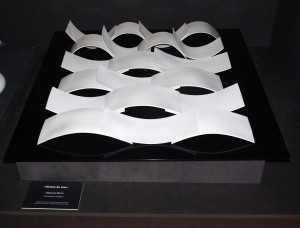« Zeste de mer » (Zest of the sea)
Marie Cagnasso
2010
100 cm x 100 cm x 20 cm
Porcelain, glazed and unglazed, lacquered metal plate
“Zeste de mer” is one of Marie’s creations that is part of her sculptures of landscapes, based on the idea “of conservation of something valuable that can disappear”. In fact the surface of the sea is on one hand mostly eternal, but in the same time absolutely volatile.
Marie captures the impression of a relatively calm sea, which reflects the sunrays so that it is meant to be only the skin of something else. This “Zest of the sea” is represented by curved elements of white porcelain. Even a moment when the sunrays are touching the water surface is conserved: the concave curved elements are unglazed and thereby matt, but the most of the convex parts are brilliant gazed, so that there appear three diagonal bright lines. The curved elements seem to be frozen waves lying on a deep black ground. However, these waves allow a glance to the depth of the sea, because they are not a closed cover. Moreover the surface is, like our skin, permeable. In contrast the black impenetrable ground might stand for the deepness of the ocean, when we see him from above.
The materials are not only chosen by necessity, but as well for their symbolic meaning: the firm lacquered metal stands for the eternal sea, however the impression of surface is fragile like the porcelain. Nevertheless, the porcelain is fixed on the ground, like the waves are inseparably joined to the sea water. As mostly in her works, Marie reduced her colour range only to black and white. It’s the biggest existing contrast that permits to see the essential of the perfect forms. No colours are misleading the contemplation.
Marie’s approach is reduced in the choice of elements and colours. It might be seen as minimalist. However the execution is so fine that one can see not only the fragility of the porcelain, but as well the impermanence of this moment-like natural phenomenon.
Marie Cagnasso
Born 1965 in Saint-Laurent-du-Var, France, Marie lives and works in Vence, France.
After years in a profession alien to art, and three years living in London, she followed finally her vocation to be an artist.
From 2006 to 2007 she frequented the Ecole des Beaux-arts (School of Fine Arts) of Vallauris – Golfe-Juan, France, and got the diploma “Arts du Feu” (arts of fire). Subsequently she was selected for the one year specialised class “Jeune Createur” (Young Creator) also in Vallauris. 2009 Marie was chosen in the international contest for porcelain creation of Limoges, France (Concours international de création en porcelain) to realise her submitted project in a residency in this traditional porcelain town. The resulting artwork was “Zeste de mer”, which was 2010 first presented in the “Galerie des Hospices” in Limoges. Another residency in Hódmezővásárhely, Hungary followed 2012.
In 2013 Marie was selected for the exhibitions “Jeune Plasticiens” (Young sculptors) in Saint Raphaël and the “Small Art Object” in Vallauris, where she was one of ten Select Award winners. For her participation at the “Terra Rossa”, Maison de la Céramique (House of Ceramics) in Salernes, France, the jury acknowledged her work in the section “Avant-garde/technicité” (Avant-garde/technicality). Furthermore, she participated in many group exhibitions at the Côte d’Azur, but as well in Paris and Budapest (Hungary). In 2013 she had her first solo exhibition in the « Galerie Bleue », Vence.
Marie’s first great subject, are the natural landscapes. Here she transforms her impressions of nature – often seen from a bird’s eye view – into ceramics, like our example “Zest of the sea”. Since 2011 her researches and concerns guided her to the internal landscapes. The starting point is the brain as “mysterious landscape” and “fascinating organ”, but the resulting artworks are as well a reflexion about the thought and the “complexity of life”. Like in the natural landscapes the colours black and white are dominant. But in the internal landscapes Marie introduces more often other materials like glass and paper. They seem to be more present in the resulting artworks; they are less subordinated to the ceramics than in the other series.
